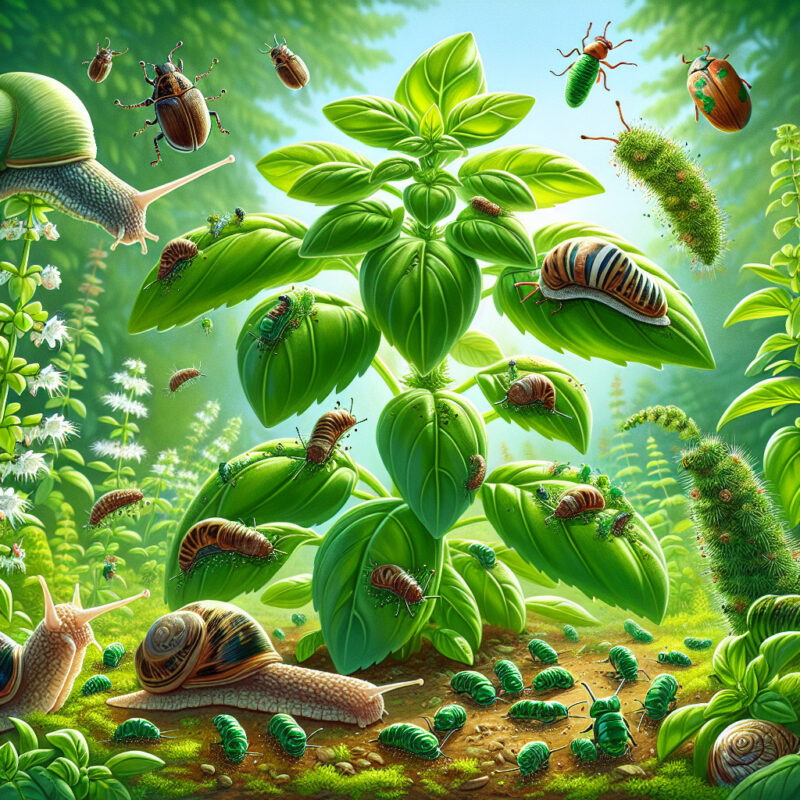Basil plants, with their vibrant green leaves and distinctive aroma, have been a coveted herb in culinary traditions across the globe for centuries. These fragrant plants not only enhance the flavors of numerous dishes but also add a touch of beauty to any garden. However, their popularity doesn’t stop with humans alone. Just like any other plant species, basil plants are part of a larger ecosystem and are subject to being food for various creatures in the animal kingdom. In this article, we will explore the diverse array of organisms that feast on basil leaves, unravelling the intriguing dynamics of nature’s intricate food chain.
key Takeaways
- Multiple pests can eat basil plants, including insects and animals.
- Common pests that eat basil plants include aphids, caterpillars, slugs, and snails.
- Aphids are tiny insects that suck sap from basil plants, causing damage and stunting growth.
- Caterpillars, such as the basil’s arch enemy, the tomato hornworm, can quickly defoliate basil plants.
- Slugs and snails are nocturnal pests that can devour basil leaves, leaving behind slimy trails.
- Preventive measures like regular inspection, use of barriers, and companion planting can help deter pests.
- Organic pest control options include handpicking, insecticidal soaps, neem oil, and companion planting.
- Avoid using chemical pesticides on basil plants, as these can be harmful to both the plant and humans.
- Encouraging natural predators like ladybugs, spiders, and birds can help control basil plant pests.
- Knowing the signs of pest damage and closely monitoring plants are crucial for early pest detection.
What Eats Basil Plants?
Basil Plant
A basil plant, scientifically known as Ocimum basilicum, is a popular culinary herb in the mint family. It is widely cultivated for its aromatic leaves, which are commonly used in various cuisines for their distinct flavor and fragrance.
Predators
Several pests and animals are known to feed on basil plants, causing damage to their leaves and stems. These predators can pose a threat to the growth and health of basil plants.
Pests That Feed on Basil Plants
1. Aphids
Aphids are small, soft-bodied insects that suck the sap of basil plants. They can multiply rapidly and weaken the plant, causing leaves to curl and yellow. These pests leave behind a sticky residue called honeydew, which serves as a breeding ground for sooty mold.
2. Spider Mites
Spider mites are tiny arachnids that feed on basil plants by piercing the plant cells and sucking out the contents. They cause yellowing of leaves, webbing, and stunted growth. Infested plants may also develop a bronze or silver appearance on the leaves.
3. Slugs and Snails
Slugs and snails are mollusks that feed on basil plants, especially during humid conditions. They leave irregular holes in the leaves and can severely damage young plants. These pests are commonly active during nighttime and thrive in moist environments.
4. Whiteflies
Whiteflies are tiny, winged insects that suck the sap from basil plants, causing leaves to turn yellow and dry out. They secrete a sticky substance called honeydew, which promotes the growth of sooty mold. Whiteflies are known to infest basil plants in large numbers.
5. Caterpillars
Caterpillars, the larval stage of butterflies and moths, can consume basil plant leaves voraciously. They can rapidly strip a plant of its foliage, often leaving only the stems. Common caterpillars that feed on basil plants include cabbage loopers and tomato hornworms.
Animals That Eat Basil Plants
1. Rabbits
Rabbits are herbivorous animals that feed on various plants, including basil. They can graze on the leaves and stems, causing significant damage to basil plants. Rabbits are known to be active during dawn and dusk periods.
2. Deer
Deer are large herbivores that can be a threat to basil plants, especially in areas close to wooded or natural habitats. When food is scarce, deer may consume basil plants along with other vegetation. Their browsing can cause severe damage to young or unprotected plants.
3. Groundhogs
Groundhogs, also known as woodchucks, are another animal that may feed on basil plants. These burrowing rodents have a broad diet that includes various plants. Groundhogs can cause significant destruction to basil plants through their feeding activities.
How can I protect my basil plants from being eaten?
There are several methods you can employ to protect your basil plants from being eaten by pests:
What are some common pests that eat basil plants?
There are several common pests that are known to eat basil plants, including:
Are there any natural predators that eat the pests that eat basil plants?
Yes, there are a number of natural predators that can help control the populations of pests that eat basil plants:
Will companion planting help to deter pests that eat basil plants?
Yes, companion planting can be an effective technique in deterring pests that eat basil plants:
How can I identify if my basil plants are being eaten?
There are several signs that can indicate if your basil plants are being eaten:
Types of Fertilizers for Organic Gardening
When it comes to organic gardening, there are various types of fertilizers you can use to nourish your plants:
The Pros and Cons of Using Mulch in Your Garden
Mulching is a common practice in gardening that involves covering the soil with a layer of material:
1. Organic Mulch: Organic mulch is made from natural materials, such as wood chips, straw, leaves, or grass clippings. It helps retain moisture in the soil, regulate soil temperature, suppress weed growth, and improve soil structure. However, it can also attract pests and may decompose quickly, requiring frequent replenishment.
2. Inorganic Mulch: Inorganic mulch includes materials like plastic, gravel, or rubber. It helps control weed growth, retain soil moisture, and prevent erosion. It does not decompose and can thus last longer than organic mulch. However, it does not provide any nutritional value to the soil and may not be aesthetically pleasing.
3. Sheet Mulching: Sheet mulching involves layering materials like cardboard, newspaper, or compost directly on top of the soil. This method suppresses weed growth, retains moisture, and can improve soil quality. It is particularly useful when establishing new garden beds.
4. Living Mulch: Living mulch involves using low-growing plants, such as clover or creeping thyme, to cover the soil. This method helps control weeds, retain moisture, and increase biodiversity in the garden. However, it may compete with the main crop for nutrients and water.
5. Compost Mulch: Compost mulch is made from fully decomposed organic matter. It enriches the soil with nutrients, improves soil structure, and helps retain moisture. However, it may attract pests if not properly managed.
Final Thoughts
In conclusion, preserving the health and integrity of your basil plants requires proactive measures to protect them from pests. By utilizing natural predators, companion planting, and regular monitoring, you can successfully prevent your basil plants from being eaten. Additionally, understanding the signs of pest damage and identifying common culprits will aid in early intervention and effective control. Remember to select the right fertilizers for organic gardening and consider the pros and cons of different types of mulch when tending to your garden. Whether you’re dealing with pests or choosing the best mulching method, these insights will empower you to maintain thriving basil plants in your garden.

